Martial Arts: Japanese Archery
Kyudo: Way Of The Bow - Part 1
By Raymond A. Sosnowski, MS, MS, MA
Editor’s
Note: This
is a two part article on Japanese archery, or way of the bow, one
of the oldest
of Japan’s traditional martial arts. Kyudo is distinguished
by the fact that it is not practiced as sport, or as a modern self-defense
system that embodies a classical military tradition, but as a form
of spiritual practice associated with Zen. This article series will
provide the reader with an overview of this spiritual art. Part 1
of this series includes the Definition of the art, Principles & Concepts,
Techniques & Training, Methods, Etiquette & Customs and
Practice Clothing/Uniforms. Part 2 covers the related topics of
Equipment,
Equipment Care, Styles, Ranking, Training Facilities, History,
and a Bibliography. A glossary of terms will appear separately. |
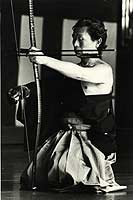
(Courtesy Don Warrener)
|
Kyudo is written with the two kanji characters for “yumi” (bow)
and “michi” (way/path), but it is pronounced “kyudo” when
written together (it’s a quirk of the Japanese language), and,
therefore, it quite literally means the “way of the bow.” Kyudo
is derived from the Japanese military practice of kyujutsu (“art/science
of the bow,” that is, combat-style archery), and it is a “moving
meditation” like the Japanese cultural arts of shodo (“way
of the brush”) and chado (“way of tea”). It is a complementary
practice to zazen (seated meditation) as Kyudo is a form of ritsuzen
(standing meditation) [e.g., Herrigel (1953), and a critical review in
Yamada (2001)].
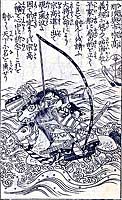 Kyudo is derived from the Japanese military practice of
kyujutsu, or combat-style archery depicted in this historic woodblock
print of a samurai using his bow while seated on a swimming hose. (Courtesy
of Christopher Caile) Kyudo is derived from the Japanese military practice of
kyujutsu, or combat-style archery depicted in this historic woodblock
print of a samurai using his bow while seated on a swimming hose. (Courtesy
of Christopher Caile)
Next to iaido (the way of Japanese sword drawing),
kyudo as an art of self-defense has no real practical uses. One is
not very
likely to use it for self-defense like karate-do, aikido (“way
of harmony”) or judo (the “gentle way”), nor even use
it for hunting. And yet, it is probably one of the most aesthetically
pleasing of all Japanese budo (martial ways), and it is one of the most
spiritual (Sosnowski, 2000); in this sense as well as visually, Kyudo
could be considered to be the Japanese analogue to the Chinese art of
T’ai Chi Ch’uan. Principles & Concepts
|
|
(Courtesy Dan and Jackie
DeProspero) (1)
|
A very basic principle in kyudo is “spirit, bow and body as one,” analogous
to “ki ken tai ichi” (“spirit, sword and body as one”)
in iaido and kendo (Japanese fencing). Instead of the uncoupled actions
of separate elements, all elements must act together as one in a coordinated
system in order to practice correctly. The ancient Chinese used ceremonial
archery to determine the quality of a man’s character (Selby, 2000),
and this idea was eventually incorporated into Japanese-style archery.
The state of mind is reflected in the attitude, form and the shot itself.
Initially “hitting the target” is relatively unimportant.
For those who practice kyudo solely as a meditation, this is always true
at face value; otherwise, it is like a koan (an illogical problem in
Zen). For all kyudo-ka (kyudo practitioners), it is a lesson in letting
go of the idea of “hitting the target;” when the baggage
of desire [“I WANT to hit the target”] is abandoned, then
through right form, the target can be hit consistently with ease. After
all, if the target really were unimportant, then there would be no purpose
in having a target at all. The actual emphasis on “hitting the
target” is specific to the individual ryuha (styles/schools and
their branches), and also depends on the individual kyudo-ka’s
developmental stage within the specific ryuha.
Many aspects for good budo practices are also present in kyudo including
metsuke (gaze), kokyo (breath), ikiai (harmony of breath), kamae (posture)
and hara (“belly” synonymous with centering and groundedness).
The aspect of “ma” (distance/timing) is also present; for
kyudo, ma is timing (considering that distance to the target is fixed),
governing the execution of proper movement. Finally, there are the various
balances: tenchi (heaven [and] earth) is the vertical balance along with
the complementary characteristics of upper and lower (supple and firm,
respectively), and migi-hidare (right-left) is the horizontal balance
in line with the mato (target). The vertical balance takes into account
gravity in the same way for a tree: the lower part, the roots and trunk,
are stable and provide the base; the upper part, the branches, are flexible
while maintaining their form and function. Both types of balance, horizontal
and vertical, have both static and dynamic manifestations.
Training
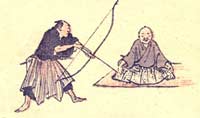 |
A historic woodblock print showing
a student practicing before his teacher. (Courtesy Christopher
Caile) |
In kyudo, as in many other budo, there are three basic
types of training: regular, individual (case-by-case), and gasshuku (intensive/seminar). “Regular
training” sessions, usually meet once or perhaps twice a week at
the same time and place; this is sometimes referred to as “formal” training,
and includes instruction and practice (some schools will include a zen
session as well). For those who practice outside of regular training,
there is “individual training,” and practicing alone fits
into this category; small groups may get together occasionally, and an
instructor may or may not be present – this is also referred to
as“informal” training. Finally, there is the “gasshuku,” a
gathering of members from different kyudojo (dojo or “practice
place” for kyudo), for concentrated practice and instruction; these
events can be from one to ten days long. For groups affiliated with the
All Nippon Kyudo Federation (ANKF), this is also a time for the taikai
(tournaments) and shinsa (promotion examinations).
Techniques & Training Methods
The kihon (basic techniques) are practiced in a kind of kihon-no-kata
(basic form); the ANKF refers to this kata as “hassetsu” (the
eight stages of shooting), whereas some lineages of Heki Ryu [refer to
STYLES below] retain the older term “shichido” (seven ways
or coordinations). These waza (techniques), in order of execution, are:
1. ashi-bumi - stepping out to position the feet and establish a stable
base.
2. do-zukuri - repositioning the body and the yumi, and then nocking
the ya (arrow).
3. yumi-gamae – engaging the tsuru (bowstring) with
the kake (shooting glove).
4. uchi-okoshi - raising the yumi.
5. hiki-wake in hassetsu; hiki-tori in
shichido - drawing the yumi.
6. kai (literally “meeting”) – pause
at full draw.
7. hanare - release.
8. zanshin - lingering mind and body.
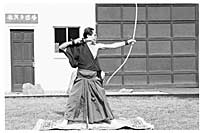 |
Kanjuro Shibata (c. 1990) in
Kai at the Ryuko Kyudojo in Boulder, CO. (Courtesy Zenko
International)
|
In shichido, the final two waza are counted together (zanshin is considered
a continuation of hanare) rather than separately. In essence, hassetsu
and shichido refer to the same set of kihon.
Although beginners can be trained individually, it is common to have
group training for beginners. Beginners concentrate on the kihon (basics).
Initially the beginner is without a kake (also referred to as a yugake),
just a yumi and ya, getting the feel of them. The ya is dropped off before
the drawing step; you go through the motion of drawing without drawing,
and through the motion of release without an actual release [one should
NEVER draw and release a real yumi without a ya - the yumi could be damaged].
Surgical tubing attached to a wooden handle (affectionately referred
to as “baby yumi” in some circles) is used to simulate the
stresses of drawing and releasing on the hands; the wooden handle is
held in the left hand, and the right hand pulls the tubing back in a
drawing motion. Then one puts on the kake and runs through the basic
sequence again, this time integrating the feel of using the kake into
the kihon. When the instructor determines that the beginner has got the
kihon down well enough, then a full draw and release are allowed at the
makiwara (short-distance target); this practice of short-distance shooting
is explained below.
Group instruction can be used for experienced students, but only to
instruct the overall form of the kata. Individual mentoring of experienced
students is required; corrections and fine-tuning are highly individualized
for the most part. Another aspect is visual learning or “stealing
with the eyes,” which is Japanese custom; Westerners tend to be
overly verbal, and, as such, are prone to asking too many questions and
demanding answers that they are usually not ready to hear. Given the
nature of kyudo, visual learning is not very difficult after a little
practice.
To train for form, especially in confined spaces, there is short-distance
shooting at the makiwara; traditionally round straw butts are used in
Japan, while hay or straw bales (sometimes wrapped in a sheet) are common
in the West (other materials such as styrofoam and rolls of corrugated
cardboard have been used as satisfactory substitutes). The makiwara is
on a stand at head height for standing shots. The kyudo-ka stands one
yumi-length away relative to the centerline of the body. The kihon-no-kata,
and any forms with a standing shooting position are practiced at the
makiwara; kneeling forms can be practiced at a makiwara on an appropriately
low stand.
Shooting is general done in a group setting, although the timing of
the sequence is individual. For even-numbered groups, there are also
various types of group shooting, including synchronized (all together),
sequential (singly or in synchronized pairs), and alternating synchronized
(people in odd-numbered positions are synchronized, as are the people
in the even-numbered positions; the two subgroups shoot sequentially);
the lead person in the first position sets the pace for the entire group.
Group shooting helps to bring one’s skill level up.
Etiquette & Customs
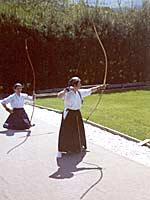 A pair of female Kyudo-ka, doing alternate shooting in
Hitote from the shooting platform at Seiko Kyudojo, Karme-Choling, Barnet,
VT, in June 2000. The standing Kyudo-ka is in Kai. (Courtesy of the
author) A pair of female Kyudo-ka, doing alternate shooting in
Hitote from the shooting platform at Seiko Kyudojo, Karme-Choling, Barnet,
VT, in June 2000. The standing Kyudo-ka is in Kai. (Courtesy of the
author)
The one word most often identified with kyudo is “dignified” -
every aspect is done with dignity. Another closely associated term is “courtesy.” So
it is not too surprising that the two types of rei (bows), tachi-rei
(standing bow) and za-rei (seated bow), are part of the initial lessons
in kyudo. Similarly, there is special consideration given to the instruction
of ashi-sabaki (foot work) in order to maintain dignified movement.
For practical reasons, there is a set of customs for shooting while
wearing a kimono because the left sleeve will get in the way of shooting
if not taken care of. The method for handling this problem is gender-specific.
Men perform hadanaugi-dosa, removing the left arm from the sleeve in
order to shoot with a bare left arm and shoulder; when finished, men
perform hadaire-dosa, replacing the left arm into the sleeve. Women,
on the other hand, perform tasuki-sabaki (cord motion); the kimono sleeves
are tied up with a cord or sash (O’Brian and Hartman, 1998).
Apart from the kihon, there is an additional set of kata that is practiced;
these are the koryu (classical style) forms. The ANKF has created a series
of “standardized” forms based on koryu kata, referring to
them collectively as “ceremonial shooting” (O’Brien,
1994). We can classify the koryu kata as standard, formal and special.
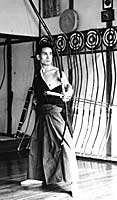 Kanjuro Shibata in his 20s in his Kyudojo Kanjuro Shibata in his 20s in his Kyudojo
in Kyoto; the posture is Sumashi
(addressing the target) in the form
called
Hitote.
(Courtesy Zenko
International)
There are three types of “standard forms” based on kneeling
or standing during the preparation work (getting to the point of having
the ya nocked) and on kneeling or standing during the actual shooting
(aligning the body, and then raising, drawing and releasing): (1) standing
during both the preparation and shooting, (2) kneeling during the preparation
and standing during shooting, and (3) kneeling during both the preparation
and shooting. The details vary among the various groups. “Formal
shooting,” usually referred to as reisha or sharei, is a variation
of the type-2 standard form, and has either one or two kaizoe (attendants);
again details vary among the various groups. Finally, there are the “special
forms,” which vary considerably among the different groups in terms
of number and use. For example, some ryuha have one or more funeral forms,
which are performed after the death of a headmaster, senior instructor,
an influential kyudo-ka (for example, see Sosnowski, 1999a), or a close
family member. Heki Ryu Chikurin-ha Kyudo also retains several special
forms from its kyujutsu origins, including a kneeling form referred to
as “castle shooting” in which the archer shoots up in a near
vertical trajectory, which comes from a medieval Japanese siege technique
of lobbing arrows over a castle wall, in order to land in a designated
circular area on the ground.
Practice Clothing/Uniforms
 The
author, almost in Kai, at the DC Sakura Matsuri (Cherry Blossom Festival)
Kyudo demonstration by Miyako Kyudojo of Silver Spring,
MD, on 30 March 2002. This was part of a three-person sequential-shooting
ceremonial form called San-nin Reisha. (Courtesy Ramona Matthews) The
author, almost in Kai, at the DC Sakura Matsuri (Cherry Blossom Festival)
Kyudo demonstration by Miyako Kyudojo of Silver Spring,
MD, on 30 March 2002. This was part of a three-person sequential-shooting
ceremonial form called San-nin Reisha. (Courtesy Ramona Matthews)
The level of practice/training determines what is worn. For informal
practice and beginner training, regular street clothes, provided that
they are clean and comfortable, but neither too loose nor too tight,
are worn. For regular practice, one generally wears a keiko-gi (a white,
short-sleeved top), an obi (a wide, thin belt, more like an iaido belt
rather than a karate belt, which is narrow and thick), a dark blue or
black hakama (wide-legged pleated trousers; women traditionally wear
a skirt that is an undivided hakama), and white tabi (split-toed socks).
Some groups specify that after a certain rank, senior practitioners wear
a kimono instead of a keiko-gi; other groups specify wearing kimono (or
equivalent) only for embu (formal demonstrations).
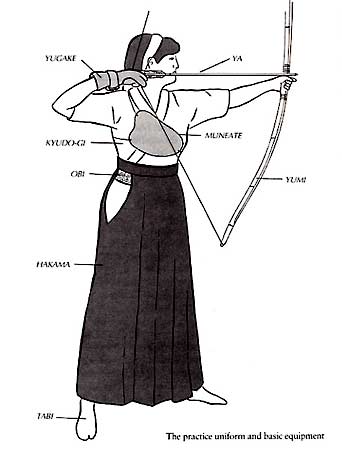 |
(Courtesy Kodansha International)
(2)
|
For embu, kimono are worn, although men may instead wear
montsuki (modified black “kimono,” which extend down only
to the mid-thigh level, with the mon or family crest on the front and
back of the sleeves and
the backs). The hakama can be a solid (but not loud) color; men generally
wear formal hakama with a two- or three-tone stripe pattern. Recall that
while shooting, women will have their kimono sleeves tied up (tasuki-sabaki),
and men will bare their left arm by slipping it out of the sleeve (hadanaugi-dosa).
The most expensive purchase is the yumi, which is a recurved, asymmetric
long bow of laminated construction. A yumi is “recurved” because,
when unstrung, its shape is the reverse of that when strung. It is “asymmetric” because
the nigiri (grip) separates the lower third from the upper two-thirds
(see Koppedrayer, 1995), and there is also a slight right-left asymmetry
as well. It is a “long bow” because its length exceeds the
height of the archer. A traditional yumi has a laminated cross section
- the facings are madake (Japanese timber bamboo) while the core and
side strips along with the sekiita (end-plates onto which the end loops
of the tsuru are attached) are hardwood; functional yumi “replica” are
made of synthetic materials like fiberglass and carbon-fiber.
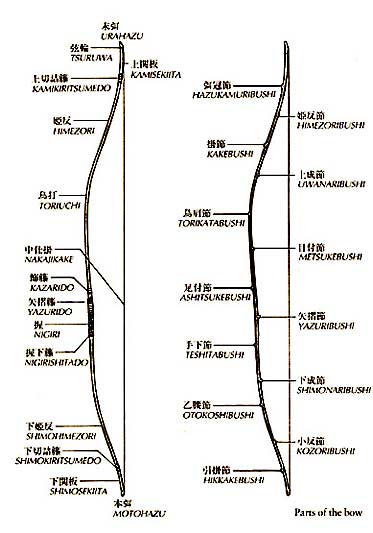 |
In
modern Kyudo three types of bows (yumi) are used: the standard
bamboo yumi, lacquered bamboo yumi, and synthetic yumi (fiberglass
or carbon) that are most often used by Kyudo schools or clubs
because of their durability. Generally, however, most traditional
practitioners prefer the non-synthetic yumi which is esthetically
parallels the essence of the practice. (Courtesy Kodansha
International) (3)
|
The size and draw strength of the yumi
are fit to the individual. The standard length of a yumi is 221 cm (87
in) based on the average
Japanese
height of 150-165 cm (59-65 in). To accommodate taller practitioners,
there are four additional lengths (6 cm [2.4 in] increments in length
for each additional 15 cm [5.9 in] in height). The draw strength varies
by gender, age, and experience. For beginners, an adult female typically
has an 8 to 14 Kg (17.6 to 30.8 lb) draw strength, while a male is between
10 and 15 Kg (22 and 33 lb). Within a year, with regular practice, practitioners
will need a stronger yumi - it is a good idea to use class yumi for the
first year for this reason. Females will average between 14 and 16 Kg
(30.8 and 35.2 lb), and males between 18 and 20 Kg (39.6 and 44 lb).
Depending on the individual, several changes in strength may be needed
over the course of many years. Yumi are typically made up to about 30
Kg (66 lb); it is the rare individual who needs one stronger. As one
ages, there comes a time when the yumi becomes too strong and one cuts
back on the draw strength. The draw strength should be sufficient to
be on the edge of a challenge (the “Goldilocks” principle
- not too much and not too little, but just right).
The size and draw strength of the yumi are fit to the individual. The
standard length of a yumi is 221 cm (87 in) based on the average Japanese
height of 150-165 cm (59-65 in). To accommodate taller practitioners,
there are four additional lengths (6 cm [2.4 in] increments in length
for each additional 15 cm [5.9 in] in height). The draw strength varies
by gender, age, and experience. For beginners, an adult female typically
has an 8 to 14 Kg (17.6 to 30.8 lb) draw strength, while a male is between
10 and 15 Kg (22 and 33 lb). Within a year, with regular practice, practitioners
will need a stronger yumi - it is a good idea to use class yumi for the
first year for this reason. Females will average between 14 and 16 Kg
(30.8 and 35.2 lb), and males between 18 and 20 Kg (39.6 and 44 lb).
Depending on the individual, several changes in strength may be needed
over the course of many years. Yumi are typically made up to about 30
Kg (66 lb); it is the rare individual who needs one stronger. As one
ages, there comes a time when the yumi becomes too strong and one cuts
back on the draw strength. The draw strength should be sufficient to
be on the edge of a challenge (the “Goldilocks” principle
- not too much and not too little, but just right).
Along with the yumi, there is the tsuru (bowstring). Just as yumi are
made in prescribed lengths, there are associated length tsuru. Traditionally,
tsuru are made of hemp; these days there are also Kevlar and hemp-Kevlar
tsuru. Hemp tsuru are generally used by experienced kyudo-ka; they require
a lot of preparation work, and are not very durable. The hemp-Kevlar
tsuru is a welcome compromise between traditional material, and ease
of handling along with good durability. One unavoidable fact is that
tsuru break, generally while shooting - the yumi should be closely inspected
after this to be sure that there is no damage, and generally there is
none; one should always carry at least one spare tsuru for this reason.
There are several ways to protect yumi in transit. Simplest is a slipcover,
a very long narrow cloth bag that the yumi fits into. There is also a
wrapper, a length of cloth in a strip, usually with a design, print,
or even calligraphy on it, having a pocket at one end that is placed
over the upper sekiita; this strip is lag-wrapped around the yumi and
secured at the lower end by tying it with the attached himo. In order
to keep yumi dry in inclement weather, there is a rain cover - a plastic
slipcover that will hold several yumi. For airline, bus or train travel,
there are no carriers that I know of. Many people use very thin plywood
strips to cover the faces of the yumi, add a layer of bubble wrap, and
secure it with duct tape. Although it is possible to use PVC pipe or
PVC fishing rod carriers, the rise height of unstrung yumi are usually
too high for the available carriers, and require the use of wide diameter
pipes that are unwieldy to handle. One should not try to force a yumi
into a container that is not wide enough to handle it; it is not good
for the yumi to be forced out of shape because shape is everything for
the yumi to operate properly.
Yumi, being made of organic material under stress, have a finite lifetime.
Every yumi has a life cycle, which can be seen in the rise height, the
distance between the grip and a line between the two sekiita on an unstrung
yumi; this can be readily seen by placing the unstrung yumi on the floor,
and then rotating the yumi so that it is perpendicular to the floor with
the sekiita still on the floor. New yumi have a rather high rise height
of two to three fists. To tame a new yumi, it is generally left strung
between four and twelve weeks as necessary to bring the rise height down
a bit. In a mature yumi, the rise height is between one and two fists;
it is only strung when in use, although for programs of three to ten
days they can usually remain strung for the duration if it is used every
day. An old yumi becomes “tired” through the loss of elasticity,
and has a rise height of no more than one fist. An old yumi should be
used seldom, and eventually it should be retired from use. Yumi can also
break – excessive dryness is the usual cause; sometimes they can
be repaired and other times they cannot.
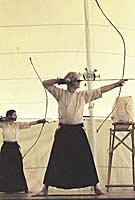 |
At right in the background is a makiwara (target) using
a hay bale: Kyudo demonstration at 2000 Cherry Blossom Festival in
Brooklyn, NY. (Courtesy Christopher Caile) |
A wooden barrel stuffed with straw is used as a makiwara
as seen in this historic woodblock print from the 1870s. (Courtesy
of Christopher Caile) |
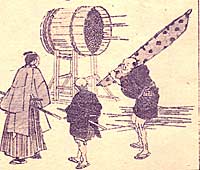
|
For short distance shooting at one bow-length away, a makiwara is used
as a target. Traditionally, it is a drum of straw on a stand. It is common
here to use straw or hay bales wrapped in a white sheet to make handling
and transport a little neater. Generally, a kyudojo will have several
on stands or holders set at varying heights to accommodate the various
statures of different practitioners. It is not uncommon for individuals
to set one up at home, either indoors or outdoors as space permits, for
their own practice.
For distance shooting, a number of mato are set up; some groups use
an odd number (resulting in more than one person per mato) while other
groups use one per archer. For standard 28 m (91.9 ft) courses, a 36
cm (14.2 in) diameter mato is used. The mato is a cylindrical wood frame
with a paper face, which is the target face; hoshi-mato have a single
black center spot, while kasumi-mato have three concentric black rings
about a white center (the outer ring goes to the rim of the target).
Use varies by school - one for regular practice and the other for special
occasions. A few individuals who have the space can set up outdoor, distance
shooting ranges. Many special programs set up temporary shooting areas
with a backstop of hay/straw bales [if possible and available, an arrow
net is set up just behind the target(s)]; otherwise, one is shooting
at a regular kyudojo (see TRAINING FACILITIES below).
Kyudo: The Essence and Practice of Japanese Archery
is available from the FightingArts Estore:
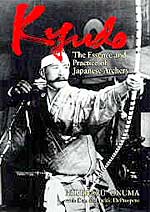
(160 p., 7½ x 10½"
hardbound., fully illustrated)
US$32.95
(+$5 shipping within US)

About The Author:
Raymond Sosnowski began his martial arts training in 1973
at the Stevens [Tech] Karate Club in "Korean Karate," which
was then a euphemism for Tae Kwon Do; he trained for over sixteen years
in the ITF (International Taekwondo Federation) style, teaching for the
majority of that time. He has practiced Kuang P'ing Yang style T'ai-Chi
Ch'uan for twelve years beginning in 1987, and taught for several years,
giving several local seminars. His first weapons were the T'ai-Chi [straight]
sword and the Chinese iron fan. He came to the Japanese martial arts
in 1991, initially training in Aikido, first Shodokan (Tomiki-Ryu) and
then Aikikai style, and Aikido weapons (aiki-ken and aiki-jo). Training
in Japanese weapons began in 1996 with Iaido, Jodo, Kendo and Naginata;
Kyudo was added in 1997. He is a yudansha (or equivalent) in all these
arts, as well as an assistant instructor of Kyudo, and an instructor
of Iaido and Naginata. The study of Nakamura Ryu (along with Toyama Ryu)
Batto-do was added in 2003. He is also a student of Zen and the Shakuhachi
("Zen flute"). Sosnowski was a co-founder (1998) and the first
Secretary of the East Coast Naginata Federation as well as the principal
author of their by-laws. He was a co-director of the Guelph [Ontario]
School of Japanese Sword Arts (GSJSA) in 1998, 1999 and 2000, and made
presentations at the panel discussions during the GSJSA in 1999 and 2000.
In addition, he was a contributing author of articles, book reviews and
seminar reports to the now-defunct publications "The Iaido Newsletter" (TIN),
and "Journal of Japanese Sword Arts" (JJSA), in addition to "Ryubi
-- The Dragon's Tail (the newsletter of Kashima Shinryu/North America)." Current
and revised writings appear in "The Iaido Journal" section
of EJMAS (Electronic Journals of Martial Arts and Sciences) at <http://ejmas.com>.
He is an occasional contributor to Iaido-L, e-Budo, the Kendo World forums
and Sword Forum International. In his professional career, Mr. Sosnowski
is an Engineering Fellow and Technical Director of Maryland Technical
Center for Sonetech Corporation (with headquarters in Bedford, NH), specializing
in artificial intelligence methodologies and computer-based numerical
analyses, as well as being an expert in all phases of software development
including government documentation. He holds three masters degrees, [Physical]
Oceanography from the University of Connecticut (Storrs, CT), [Applied]
Mathematics from Rivier College (Nashua, NH), and Cognitive and Neural
Systems from Boston University, as well as a Bachelors in Physics from
the Stevens Institute of Technology (Hoboken, NJ). He lives with his
wife Valerie in rural Maryland between Washington, DC, and Baltimore,
MD, described by a friend as "a little piece of southern New Hampshire
in Maryland."
|